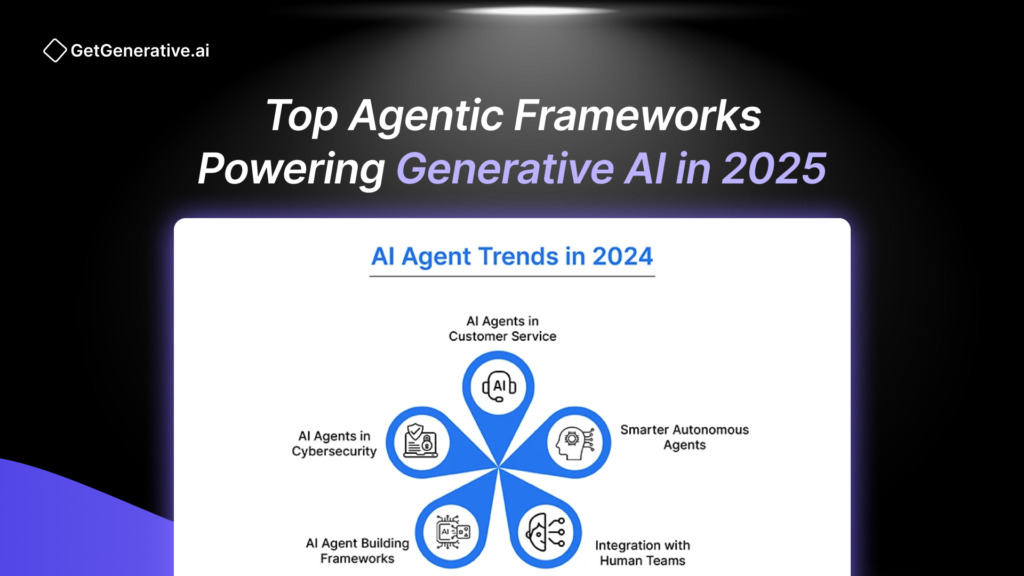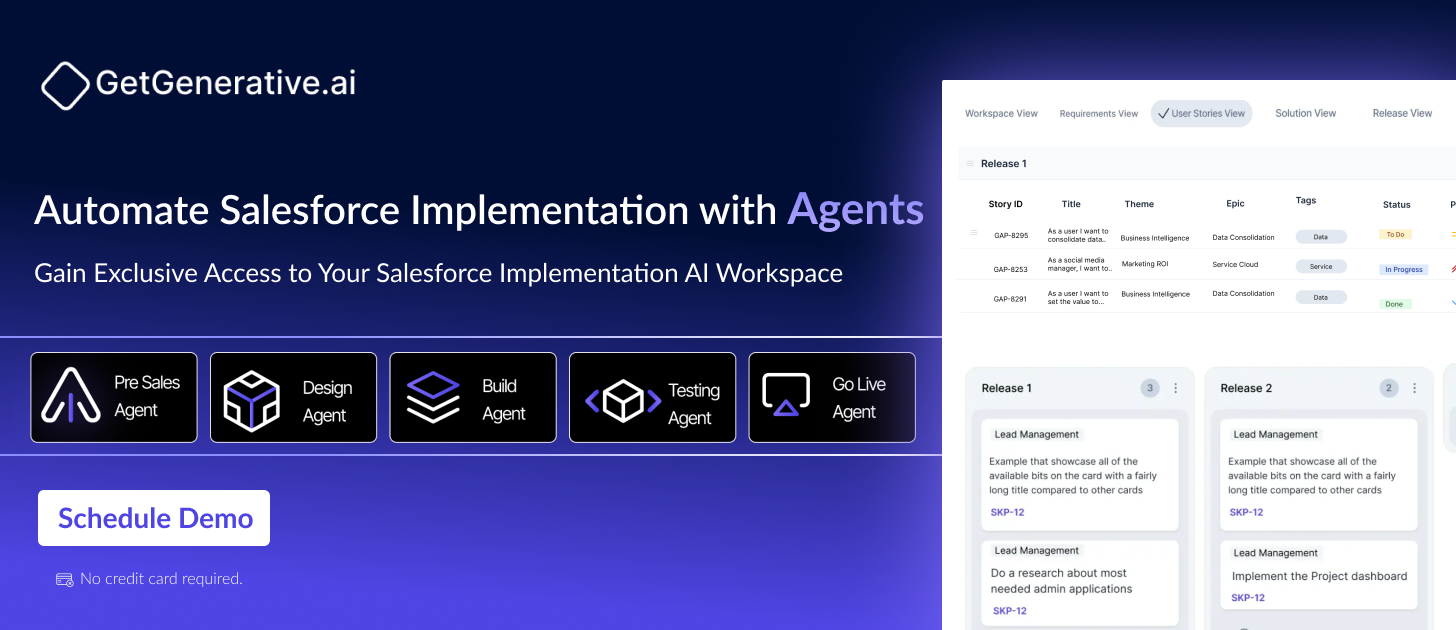Top Agentic Frameworks Powering Generative AI in 2025
In 2025, the adoption of agentic AI is accelerating, with 25% of companies utilizing generative AI launching agentic AI pilots or proofs of concept, a figure projected to reach 50% by 2027.
Generative AI is evolving beyond simple automation, moving towards intelligent, autonomous systems capable of decision-making, collaboration, and continuous learning. The key to this transformation lies in agentic AI frameworks—specialized platforms that empower AI agents to operate independently while coordinating tasks across different environments. These frameworks act as the backbone of next-gen AI applications, enabling businesses to automate complex workflows, integrate AI into enterprise systems, and optimize efficiency at scale.
2025 marks a pivotal year for agentic AI, with several frameworks leading the charge. These frameworks enhance generative AI capabilities, from workflow automation to multi-agent collaboration and real-time decision-making.
This blog explores the most powerful agentic frameworks of the year, their key features, applications, and how they’re reshaping the AI landscape.
What Are Agentic AI Frameworks?
Agentic AI frameworks provide the structural foundation for creating AI agents that function autonomously. Unlike traditional AI models that operate in isolation or require constant human input, these frameworks enable AI agents to interact, learn, and execute tasks independently. They combine large language models (LLMs), APIs, memory systems, and reasoning engines to build intelligent AI-powered workflows.
These frameworks are designed for industries requiring AI agents to handle complex, multi-step tasks, such as enterprise automation, research assistance, intelligent customer support, and self-improving AI applications.
Key Features of Agentic AI Frameworks
To power advanced generative AI applications, agentic frameworks include several key features:
- Multi-Agent Systems – These frameworks allow multiple AI agents to work collaboratively, distributing tasks efficiently to optimize performance.
- Tool Integration – AI agents can interact with APIs, databases, and third-party services to retrieve data, perform calculations, or automate processes.
- Autonomy and Decision-Making – Agents can independently analyze tasks, make decisions, and execute workflows without requiring direct supervision.
- Stateful Memory Management – AI models retain context and learn from previous interactions, improving efficiency over time.
- Task Orchestration – Frameworks enable AI agents to break down complex problems into structured workflows, ensuring smooth execution.
Also Read – What Is DeepSeek? A Complete Breakdown
Why Agentic Frameworks Are Essential for Generative AI
The demand for generative AI solutions that go beyond simple text generation is growing rapidly. Organizations need AI systems that can reason, plan, and take action based on evolving data and objectives. Agentic AI frameworks provide this capability by enabling generative AI to:
- Automate Complex Tasks – AI agents can handle multi-step workflows with logical dependencies, reducing human intervention.
- Enhance Productivity – Businesses can deploy AI agents to manage operational processes, improving efficiency and scalability.
- Integrate AI Seamlessly – These frameworks ensure AI interacts smoothly with existing business systems, databases, and APIs.
- Enable Autonomous AI Collaboration – AI agents can communicate with each other, delegate tasks, and refine outputs in real-time.
With these benefits, agentic AI is becoming indispensable across industries, from IT automation to healthcare and finance.
“We’re about to empower people more than ever before.”
- Sam Altman, CEO of OpenAI
Top Agentic AI Frameworks to Watch in 2025
Several agentic AI frameworks stand out in 2025 for their ability to orchestrate multi-agent workflows, enhance decision-making, and optimize AI-driven processes. These frameworks are shaping the future of generative AI by enabling scalable, intelligent automation.
Microsoft AutoGen: Orchestrating Multi-Agent Systems
Microsoft AutoGen is a pioneering agentic framework designed to create multi-agent systems capable of solving complex problems autonomously. It provides developers with a modular and scalable approach to AI orchestration, enabling AI agents to work together efficiently.
Key Features
- Multi-Agent Collaboration – AutoGen facilitates the coordination of multiple AI agents, allowing them to share tasks and optimize workflow execution.
- Event-Driven Architecture – AI agents respond to events dynamically, adapting to real-time data changes.
- Integration with APIs and External Tools – Supports seamless interactions with cloud services, databases, and software applications.
- Reasoning and Task Prioritization – AI agents prioritize tasks based on urgency and dependencies, ensuring efficient execution.
Why It Matters
AutoGen is a game-changer for industries that require automated problem-solving and intelligent workflow orchestration. It allows businesses to build AI-driven systems that proactively manage IT infrastructure, automate software development, and optimize cloud operations.
Use Case
A cloud service provider uses AutoGen to detect server misconfigurations, assign problem-solving tasks to specialized AI agents, and automatically implement fixes—reducing downtime and improving system reliability.
LangChain: Streamlining AI Workflows
LangChain is one of the most versatile frameworks for building generative AI applications. It enables developers to construct seamless AI workflows by chaining together multiple components such as memory, tools, and external APIs.
Key Features
- Modular AI Pipeline – Developers can design structured AI workflows using reusable components.
- Integrated Memory Management – Ensures AI agents retain context across interactions for improved decision-making.
- Compatibility with Multiple LLMs – Supports integration with OpenAI, Hugging Face, and other AI models.
- Extensive Tool Support – Enables AI agents to interact with databases, perform web searches, and retrieve external data.
Why It Matters
LangChain’s flexibility makes it an essential tool for building AI-powered assistants, retrieval-augmented generation (RAG) systems, and research automation tools. Its ability to connect AI agents with data sources ensures that AI-driven applications generate accurate, context-aware responses.
Use Case
A financial institution uses LangChain to develop an AI assistant that retrieves customer data, analyzes financial trends, and generates personalized investment recommendations—enhancing client engagement.
LangGraph: Managing Stateful AI Workflows
LangGraph extends LangChain’s capabilities by introducing a graph-based approach to AI workflow management. It is ideal for applications requiring stateful, multi-step AI interactions.
Key Features
- Graph-Based Dependency Management – AI agents execute tasks based on logical dependencies, ensuring workflows follow a structured order.
- Support for Stateful AI Applications – Enhances generative AI by enabling models to maintain long-term context.
- Seamless API and Database Integration – Connects AI workflows with enterprise data systems for real-time analytics.
Why It Matters
LangGraph is particularly useful in industries where precise task sequencing is essential. It helps organizations build AI solutions for research automation, complex document processing, and healthcare diagnostics.
Use Case
A healthcare provider uses LangGraph to develop an AI-driven diagnosis assistant that retrieves patient medical history, analyzes symptoms, and recommends potential treatments—improving diagnostic accuracy.
Microsoft Semantic Kernel: Integrating AI with Enterprise Systems
Microsoft Semantic Kernel is a robust agentic framework designed for enterprise AI integration. It enables businesses to embed AI reasoning capabilities into their existing software infrastructure.
Key Features
- Context-Aware AI Reasoning – Allows AI to understand user intent and generate relevant responses.
- Pre-Built Connectors for Enterprise Systems – Seamless integration with Microsoft’s ecosystem and other business applications.
- Semantic Understanding Capabilities – AI models interpret and process complex queries more accurately.
Why It Matters
Semantic Kernel bridges the gap between AI and enterprise workflows, making it easier to integrate AI-driven decision-making into corporate systems. It enhances automation in customer support, IT operations, and business analytics.
Use Case
An IT helpdesk uses Semantic Kernel to automate ticket resolution by interpreting user requests, classifying issues, and providing immediate AI-generated solutions—reducing workload for human support teams.
CrewAI: Facilitating Multi-Agent Collaboration
CrewAI focuses on multi-agent collaboration, allowing AI agents to work in teams, each specializing in different tasks. This framework is designed for industries that need seamless teamwork among digital agents, mimicking human organizational structures.
Key Features
- Role-Based Agent Architecture – Assigns specific roles to AI agents, enhancing specialization and efficiency.
- Task Planning and Delegation – AI agents dynamically plan and delegate tasks based on workload and priority.
- Flexible Module Integration – Supports various tools and APIs, making it adaptable across industries.
Why It Matters
CrewAI’s emphasis on collaboration makes it invaluable for complex problem-solving tasks, such as logistics management and resource allocation. Its structured approach ensures that AI agents work cohesively, improving operational efficiency.
Use Case
A logistics company uses CrewAI to manage deliveries, with AI agents handling route planning, inventory tracking, and real-time delivery adjustments, ensuring timely and cost-effective shipments.
Comparing Top Agentic AI Frameworks
Selecting the right agentic framework can be challenging, given the variety of options. Here’s a comparison to help guide your choice:
| Framework | Key Focus | Strengths | Best For |
| Microsoft AutoGen | Multi-agent orchestration | Scalability, API integration, reasoning | IT operations, cloud automation |
| LangChain | AI workflow automation | Flexibility, modularity | Chatbots, RAG systems, research automation |
| LangGraph | Stateful workflow management | Dependency management, state retention | Healthcare, document processing |
| Microsoft Semantic Kernel | Enterprise AI integration | Context-aware reasoning, system connectors | Business analytics, customer support |
| CrewAI | Multi-agent collaboration | Teamwork, task delegation | Logistics, resource planning |
Benefits of Agentic Frameworks for Generative AI
Agentic frameworks are revolutionizing generative AI by providing robust infrastructures for complex operations. Key benefits include:
- Scalability – Easily manage multiple AI agents and scale operations without manual intervention.
- Flexibility – Integrate various tools and APIs, adapting to industry-specific needs.
- Efficiency – Automate repetitive tasks, freeing up human resources for strategic activities.
- Continuous Learning – Agents retain and learn from past interactions, improving performance over time.
- Enhanced Decision-Making – AI agents analyze data, prioritize tasks, and execute decisions autonomously.
Also Read – The Ultimate Guide to LLM Benchmarks
Challenges in Implementing Agentic Frameworks
While promising, implementing agentic AI frameworks comes with challenges:
- Complexity – Setting up multi-agent systems requires significant expertise and time.
- Resource Intensiveness – Running multiple AI agents can demand substantial computational power and costs.
- Integration Issues – Ensuring seamless integration with existing systems can be challenging, especially in legacy environments.
- Maintenance – Continuous monitoring and updating are essential to maintain efficiency and accuracy.
“It’s not inconceivable that AI could wipe out humanity”
- Geoffrey Hinton, AI Pioneer
How to Choose the Right Agentic Framework
Choosing the right framework depends on your project needs, budget, and technical capabilities. Consider:
- Project Complexity – For complex, multi-step workflows, LangGraph or CrewAI are ideal.
- Industry Needs – Enterprise-focused tasks may benefit from Microsoft Semantic Kernel.
- Scalability – AutoGen is perfect for large-scale, multi-agent orchestration.
- Flexibility – LangChain offers versatility across various applications.
- Collaboration – CrewAI excels in multi-agent teamwork scenarios.
Conclusion
Agentic frameworks are no longer a futuristic concept—they are the present and future of generative AI. As AI systems become more autonomous, businesses need robust frameworks that can handle complex tasks, integrate seamlessly with existing systems, and scale effortlessly.
Supercharge your Salesforce implementation with GetGenerative.ai’s AI-powered Workspace + Agents, managing your entire lifecycle from Pre-Sales to Go-live seamlessly!
FAQs
1. What are agentic AI frameworks?
Agentic AI frameworks are software platforms that enable AI agents to operate autonomously, managing tasks, interacting with tools, and improving through learning.
2. Why are agentic frameworks important for generative AI?
They provide the structure for AI agents to handle complex tasks independently, enhancing scalability, efficiency, and automation in AI applications.
3. Which is the best agentic framework for enterprise AI?
Microsoft Semantic Kernel is ideal for enterprise AI integration due to its context-aware reasoning and seamless connectivity with business systems.
4. Can agentic frameworks support multi-agent collaboration?
Yes, frameworks like CrewAI and AutoGen are specifically designed for multi-agent collaboration, enabling AI agents to work together on complex problems.
5. How do I choose the right agentic AI framework?
Assess your project needs, industry requirements, and scalability goals. For versatility, choose LangChain; for multi-agent orchestration, AutoGen; for enterprise integration, Semantic Kernel.




